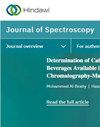Vibrational Biospectroscopy in the Clinical Setting: Exploring the Impact of New Advances in the Field of Immunology
IF 2.1
4区 化学
Q4 BIOCHEMICAL RESEARCH METHODS
引用次数: 0
Abstract
The investigation of pathological diseases largely relies on laboratory examinations. The ability to identify and characterise cells is an essential process for clinicians to reach an accurate diagnosis and inform appropriate treatments. There is currently a gap between the advancement of scientific knowledge on cellular and molecular pathways and the development of novel techniques capable of detecting subtle cellular changes associated with disease. Biospectroscopy is the use of spectroscopy techniques to investigate biological materials. Within a biological sample, important molecules such as lipids, carbohydrates, nucleic acids, and proteins are held together by chemical bonds; these bonds will vibrate following excitation with infrared light. By measuring the vibrational energy of each molecule present in a biological sample, a unique spectrum, known as the “molecular fingerprint” is generated. As disease-related changes in biological samples will be reflected in the molecular fingerprint, biospectroscopy is a well-placed candidate for the investigation of disease. Biospectroscopy has been gaining wider acceptance and application in the clinical setting over the past decade; however, it has yet to reach diagnostic laboratories and healthcare clinics as a routine platform for clinical assessment. Immunological disorders are complex, often demonstrating interaction across multiple molecular pathways which results in delayed diagnosis. Vibrational spectroscopy is being applied in many fields, and here we present a review of its use in cellular immunology. Potential benefits, including an enhanced definition of molecular processes and the use of spectroscopy in disease diagnosis, monitoring, and treatment response, are discussed. The translation of vibrational spectroscopic techniques into clinical practice offers rapid, noninvasive, and inexpensive methods to obtain information on the molecular composition of biological samples. The potential clinical benefits of biospectroscopy include providing a more prompt and accurate disease diagnosis, thus improving patient care and resulting in better health outcomes.临床中的振动生物能谱学:探索免疫学领域新进展的影响
病理疾病的研究主要依赖实验室检查。对临床医生来说,识别和描述细胞特征的能力是准确诊断和提供适当治疗信息的必要过程。目前,有关细胞和分子途径的科学知识的发展与能够检测与疾病相关的细微细胞变化的新型技术的开发之间存在差距。生物光谱学是利用光谱学技术研究生物材料。在生物样本中,脂质、碳水化合物、核酸和蛋白质等重要分子通过化学键结合在一起;这些化学键在红外光的激发下会发生振动。通过测量生物样本中每个分子的振动能量,就能生成一个独特的光谱,即 "分子指纹"。由于生物样本中与疾病有关的变化会反映在分子指纹中,因此生物光谱学是研究疾病的理想方法。在过去的十年中,生物光谱学在临床环境中得到了越来越广泛的接受和应用;然而,它尚未作为临床评估的常规平台进入诊断实验室和医疗诊所。免疫性疾病非常复杂,往往表现出多种分子途径之间的相互作用,从而导致诊断延迟。振动光谱技术正被应用于许多领域,在此我们将对其在细胞免疫学中的应用进行综述。本文讨论了振动光谱学的潜在优势,包括增强分子过程的定义以及在疾病诊断、监测和治疗反应中的应用。将振动光谱技术应用于临床实践提供了快速、无创和廉价的方法来获取生物样本的分子组成信息。生物光谱学的潜在临床益处包括提供更及时、更准确的疾病诊断,从而改善病人护理,提高健康水平。
本文章由计算机程序翻译,如有差异,请以英文原文为准。
求助全文
约1分钟内获得全文
求助全文
来源期刊

Journal of Spectroscopy
BIOCHEMICAL RESEARCH METHODS-SPECTROSCOPY
CiteScore
3.00
自引率
0.00%
发文量
37
审稿时长
15 weeks
期刊介绍:
Journal of Spectroscopy (formerly titled Spectroscopy: An International Journal) is a peer-reviewed, open access journal that publishes original research articles as well as review articles in all areas of spectroscopy.
 求助内容:
求助内容: 应助结果提醒方式:
应助结果提醒方式:


